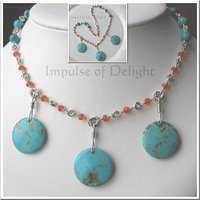 Turquoise is one of my very favorite stones - it comes in such a lovely array of blues and greens, and ranges from wonderfully organic natural nugget shapes with fascinating matrix patterns to the icy blue sophistication of Sleeping Beauty. Sadly, being so beloved and popular, it is also the subject of a plethora of fakes, forgeries and misinformation. I thought I would take a moment to share the fruits of my research to date, and help shed some light on common terminology and misconceptions. Most of this is taken from my own Materials Index.
Turquoise: A hydrated aluminum copper phosphate, often containing iron. There are many forms of genuine turquoise, as well as numerous imitations. The color encompasses the entire spectrum from blue to green, with various amounts and patterning of black or brown matrix. Turquoise is a soft stone and specimens which are hard enough to be usable in their natural state are rare. The form which I refer to simply as turquoise is stabilized.
Hardness: 5-6
Terms in common usage include:
Natural turquoise - technically should refer only to the highest grade which is hard enough to be used in un-enhanced form - it will absorb body oils and turn green over time. Vendors often call any non-imitation form of turquoise "natural".
Sleeping Beauty turquoise - a popular high grade form with a brilliant blue color and little or no matrix, from the Sleeping Beauty mine in Arizona. Because of it's desirability, pretenders abound and the term is much abused.
Stabilized turquoise - The most commonly available form - impregnated with resin which serves to harden the stone and deepen the color (much as rocks appear darker when wet). Chinese forms may also include wax and/or dye enhancement. Even stabilized turquoise will absorb body oils and darken over time.
Mexican turquoise - mined in Mexico, unique in that it occurs naturally as free-form nuggets. Stabilized.
Tibetan turquoise - originating in that region, traditionally stabilized, generally harder than most varieties, and takes a nice polish.
Mojave turquoise - chunks of turquoise compressed into a block with plastic resin filler and dyed green. A similar product in purple is being marketed as "purple Sleeping Beauty turquoise".
African "turquoise" - actually a blue green jasper mined in Africa
Chalk "turquoise" - a pale stone (often not turquoise) which has been dyed - commonly brilliant blue or lime green.
Howlite "turquoise" - a pale, black-veined stone commonly dyed to simulate turquoise.
Reconstituted "turquoise" - implied to be ground up turquoise assembled with plastic resin - reliable sources suggest that it is generally, in fact, entirely plastic. I don't use this form.
Care: Avoid scratches and sharp blows, as well as hot water and household chemicals.
Turquoise is one of my very favorite stones - it comes in such a lovely array of blues and greens, and ranges from wonderfully organic natural nugget shapes with fascinating matrix patterns to the icy blue sophistication of Sleeping Beauty. Sadly, being so beloved and popular, it is also the subject of a plethora of fakes, forgeries and misinformation. I thought I would take a moment to share the fruits of my research to date, and help shed some light on common terminology and misconceptions. Most of this is taken from my own Materials Index.
Turquoise: A hydrated aluminum copper phosphate, often containing iron. There are many forms of genuine turquoise, as well as numerous imitations. The color encompasses the entire spectrum from blue to green, with various amounts and patterning of black or brown matrix. Turquoise is a soft stone and specimens which are hard enough to be usable in their natural state are rare. The form which I refer to simply as turquoise is stabilized.
Hardness: 5-6
Terms in common usage include:
Natural turquoise - technically should refer only to the highest grade which is hard enough to be used in un-enhanced form - it will absorb body oils and turn green over time. Vendors often call any non-imitation form of turquoise "natural".
Sleeping Beauty turquoise - a popular high grade form with a brilliant blue color and little or no matrix, from the Sleeping Beauty mine in Arizona. Because of it's desirability, pretenders abound and the term is much abused.
Stabilized turquoise - The most commonly available form - impregnated with resin which serves to harden the stone and deepen the color (much as rocks appear darker when wet). Chinese forms may also include wax and/or dye enhancement. Even stabilized turquoise will absorb body oils and darken over time.
Mexican turquoise - mined in Mexico, unique in that it occurs naturally as free-form nuggets. Stabilized.
Tibetan turquoise - originating in that region, traditionally stabilized, generally harder than most varieties, and takes a nice polish.
Mojave turquoise - chunks of turquoise compressed into a block with plastic resin filler and dyed green. A similar product in purple is being marketed as "purple Sleeping Beauty turquoise".
African "turquoise" - actually a blue green jasper mined in Africa
Chalk "turquoise" - a pale stone (often not turquoise) which has been dyed - commonly brilliant blue or lime green.
Howlite "turquoise" - a pale, black-veined stone commonly dyed to simulate turquoise.
Reconstituted "turquoise" - implied to be ground up turquoise assembled with plastic resin - reliable sources suggest that it is generally, in fact, entirely plastic. I don't use this form.
Care: Avoid scratches and sharp blows, as well as hot water and household chemicals.
Friday, February 17, 2006
Turquoise
Posted by
Ruth
at
2/17/2006 10:56:00 AM
![]()
Subscribe to:
Post Comments (Atom)

1 comment:
I make jewelry too. You have some lovely pieces here - I love the knitted leaf earrings! Check out my blog if you want - I haven't added any new jewelry in a few weeks, so you'll have to scroll down to find anything. I'm in grad school, so updating sometimes gets lost in all my other work! Anyway, best of luck!
Post a Comment